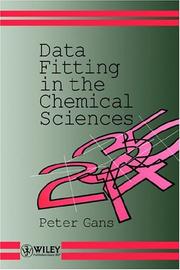| Listing 1 - 10 of 1238 | << page >> |
Sort by
|
Book
Year: 1969 Publisher: Delft : Dept. of Mechanical Engineering, Delft University of Technology,
Abstract | Keywords | Export | Availability | Bookmark
 Loading...
Loading...Choose an application
- Reference Manager
- EndNote
- RefWorks (Direct export to RefWorks)
Book
Year: 1965 Publisher: Cambridge : Cambridge University Press,
Abstract | Keywords | Export | Availability | Bookmark
 Loading...
Loading...Choose an application
- Reference Manager
- EndNote
- RefWorks (Direct export to RefWorks)
Tables --- Curve fitting --- Curve fitting
Book
Year: 1965 Publisher: Paris : Arts et métiers graphiques,
Abstract | Keywords | Export | Availability | Bookmark
 Loading...
Loading...Choose an application
- Reference Manager
- EndNote
- RefWorks (Direct export to RefWorks)
Book
ISBN: 1003021689 1000166201 1003021689 1000166120 Year: 2020 Publisher: New York : Routledge,
Abstract | Keywords | Export | Availability | Bookmark
 Loading...
Loading...Choose an application
- Reference Manager
- EndNote
- RefWorks (Direct export to RefWorks)
"The book comprehensively studies the dynamic mechanism of inflation in China from the perspective of New Keynesian Economics, deploying the traditional Phillips curve and incorporating factors of globalization and financialization in the inflation formation regime of modern China"--
Book
ISBN: 9781003021681 9780367898823 9780367536039 Year: 2021 Publisher: London Routledge
Abstract | Keywords | Export | Availability | Bookmark
 Loading...
Loading...Choose an application
- Reference Manager
- EndNote
- RefWorks (Direct export to RefWorks)
Inflation plays a central role in macroeconomic and financial policy regulation, and its dynamic formation has gradually become a popular research topic in this field. This book comprehensively studies the dynamic mechanism of inflation in China from the perspective of New Keynesian economics.By combining the dynamic trajectory of price changes since China's reform and opening-up under Deng Xiaoping as well as the underlying economic operating characteristics, the book deploys a multifaceted approach to understand the mechanism of inflation dynamics. The author explores the microfoundations of inflation dynamics, and underlines their importance in the context of modern monetary policy. In particular, he builds upon the traditional New Keynesian Phillips curve to include factors of globalization and financialization within the inflation formation regime of modern China.As the book explores the dynamic mechanism of China's inflation from different perspectives including inflation cycle theory, price index internal conduction, price index chain transmission, capital rotation, and industry inflation mechanisms, international readers will gain a full understanding of China's inflation, monetary policy, and economy.
Book
Year: 1987 Publisher: [Washington, D.C.] : National Aeronautics and Space Administration, Scientific and Technical Information Office,
Abstract | Keywords | Export | Availability | Bookmark
 Loading...
Loading...Choose an application
- Reference Manager
- EndNote
- RefWorks (Direct export to RefWorks)
Book
Year: 2003 Publisher: Washington, D.C. : World Bank,
Abstract | Keywords | Export | Availability | Bookmark
 Loading...
Loading...Choose an application
- Reference Manager
- EndNote
- RefWorks (Direct export to RefWorks)
Book
Year: 1978 Publisher: Cambridge, Mass. National Bureau of Economic Research
Abstract | Keywords | Export | Availability | Bookmark
 Loading...
Loading...Choose an application
- Reference Manager
- EndNote
- RefWorks (Direct export to RefWorks)
The persistence of inflation during periods of high unemployment poses the central problem for macroeconomic policy in coming years. The extent of success in reducing both inflation and unemployment will depend strongly on the short-run responsiveness of wage inflation to unemployment and excess capacity. This paper studies changes in the cyclical responsiveness of inflation from 1890-1976, and concludes that a given shortfall in production relative to potential now "buys" a smaller reduction in the rate of inflation than in the past. From 1890-1929, a one percent decline in industrial production reduced inflation about .45%; for 1950-1976, the same output decline is estimated to slow inflation only about .l%. The analysis makes use of two methods to study the changing cyclical behavior of inflation. Following an innovative study by Cagan, calculations are made for wage and price inflation before and after eighteen business cycle peaks. While inflation slows in almost every recession, the declines in inflation in recent years are less pronounced than earlier, even when controlling for business cycle severity. In a second section of the study, econometric evidence is provided that also strongly supports the hypothesis of increasing rigidity of wage and price Inflation over the business cycle. In the last section of the paper, some possible reasons are cited for the declining responsiveness of inflation to unemployment. Ironically, successful macroeconomic policy might be in part responsible. To the extent that activist macroeconomic policy breaks the link between current unemployment and expectations of future unemployment, it is argued, unemployment today will not induce wage cuts in contracts for future periods. Also, the tremendous increase in duration and coverage of collective bargaining agreements is suggested as an important force behind the shifting behavior of wages and prices during the period of study.

ISBN: 0471934127 9780471934127 Year: 1992 Publisher: Chichester Wiley
Abstract | Keywords | Export | Availability | Bookmark
 Loading...
Loading...Choose an application
- Reference Manager
- EndNote
- RefWorks (Direct export to RefWorks)
Mathematical statistics --- Least squares --- Curve fitting. --- Least squares. --- Curve fitting
Book
Abstract | Keywords | Export | Availability | Bookmark
 Loading...
Loading...Choose an application
- Reference Manager
- EndNote
- RefWorks (Direct export to RefWorks)
| Listing 1 - 10 of 1238 | << page >> |
Sort by
|

 Search
Search Feedback
Feedback About UniCat
About UniCat  Help
Help News
News